|
Listen to this article  |
The 2023 World Ag Expo took place in early February in Tulare, CA, deep in the heart of the California central valley. The show kicked off with an introduction by US House of Representatives Speaker of the House Kevin McCarthy.
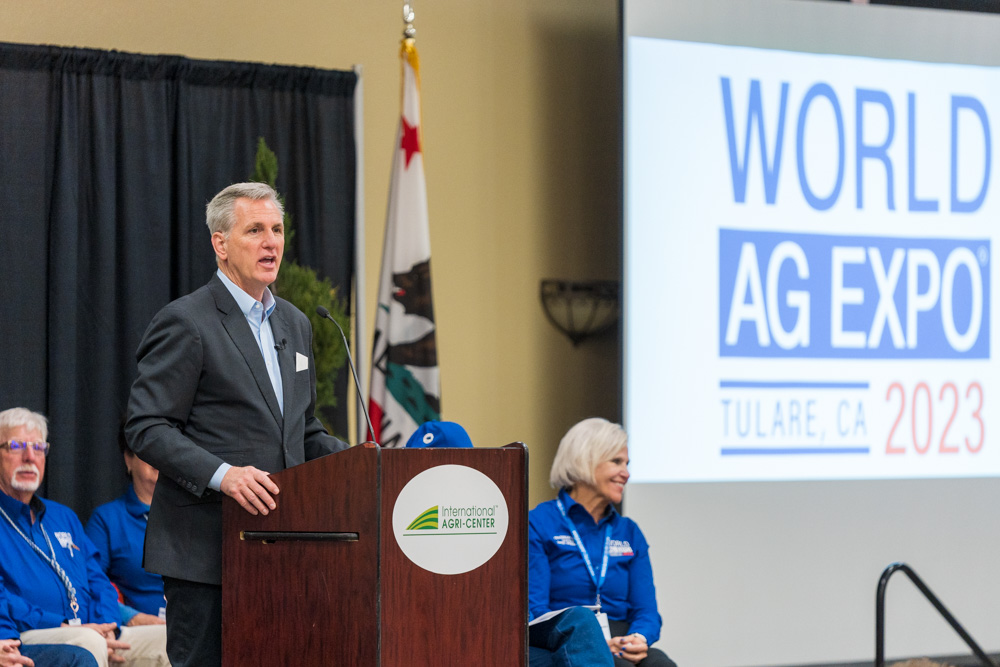
US Speaker of the House Kevin McCarthy addresses the crowd during the opening session of the World Ag Expo 2023. | Credit: The Robot Report
Speaker McCarthy is a native of nearby Bakersfield and Tulare is in the district that he represents. The speaker along with several other senators and representatives from other ag-heavy states were present on day one of the show for an important “listening session” related to the upcoming farm bill which is up for renewal this spring in the US Congress.
Tevel Aerobotics

The new Tevel Alphabot is a partnership between Tevel Aerobotics and S&S Harvesting. | Credit: The Robot Report
Tevel Aerobotics is the 2021 recipient of an RBR50 innovation award for fruit-collecting drones. Tevel’s major announcement at the 2023 World Ag Expo (WAE) is a new relationship with S&S Metal Fabrication to produce an automated platform harvester to support the Tevel drones as they move down a row.
The new S&S mobile base is a derivative of the existing S&S Alpha-1 platform harvester and is about 8 ft wide and 25 ft long. The vehicle features a soft conveyor belt in the middle of the vehicle to gently move the fruit to storage bins that accumulate and deposit the fruit into larger bins. These bins are then dropped off within the rox behind the autonomous vehicle as it progresses down a row within the orchard.
Many observers of the initial Tevel fruit-picking demo last year pointed out that the drones were dropping the harvested fruit from too high and that it would likely damage the fruit. Tevel has solved this problem through the implementation of a canvas drop zone that catches the fruit deposited by a drone and then lets the fruit fall a short, repeatable distance to the conveyor.
Agtonomy
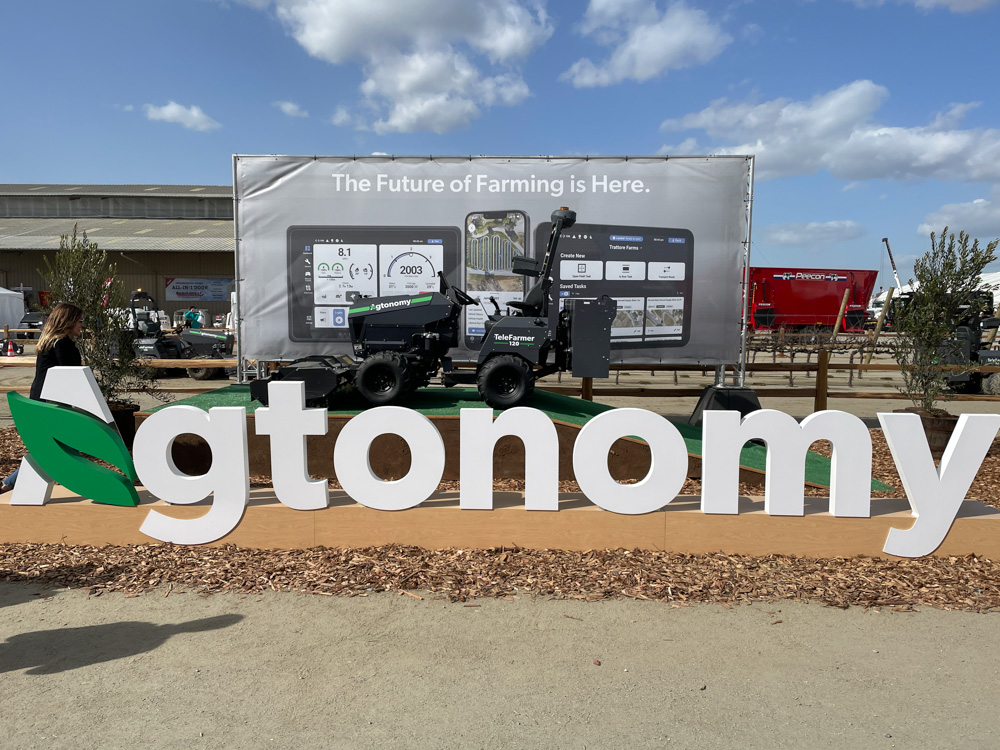
Agtonomy launched its new Tele-Farmer solution at World Ag Expo 2023. | Credit: The Robot Report
Agtonomy launched its new Tele-farmer solution at the 2023 WAE show.
This was the biggest robotic agriculture new product announcement at the show. Agtonomy is a startup headquartered in South San Francisco.
The Tele-Farmer solution is positioned as a farm management software solution BUT the company demonstrated a fleet of what they’re describing as reference tractors automated by their Tele-Farmer software solution.
The solution is primarily targeted at high-value crops and orchard workflows like mowing, spraying, and weeding.
Tele-Farmer features two novel capabilities:
- Trunk Vision is an ai-based vision model designed to track the trunks of trees and navigate accurately through an orchard row.
- An autonomous battery changing feature that can autonomously place a dead battery onto the charger and then pick up a fully charged battery from a nearby charging dock.
Nexus Robotics
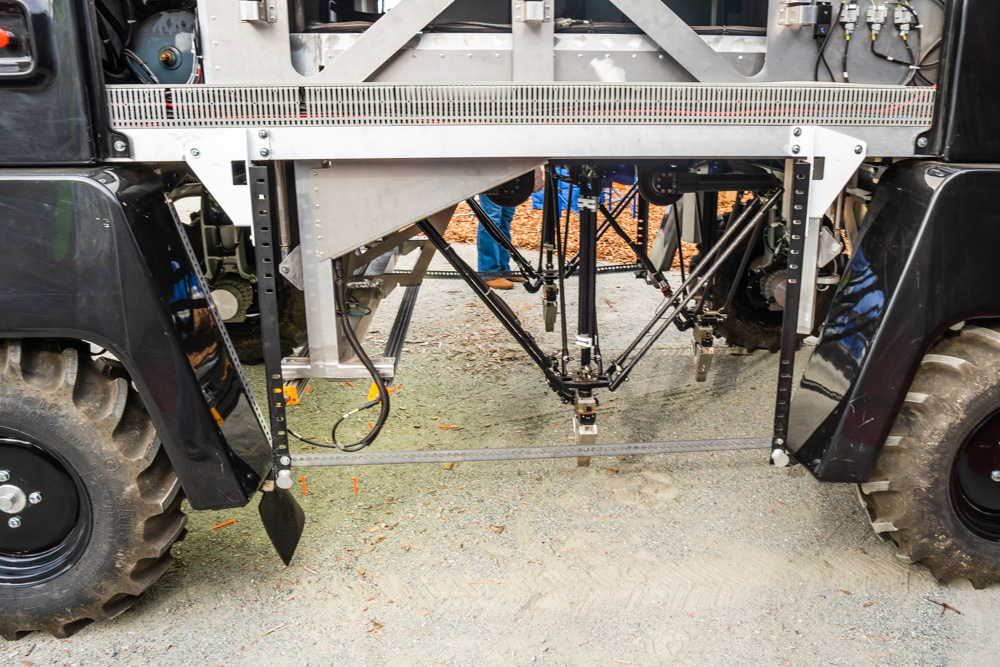
The Nexus Robotics weeder employs delta-style robot arms to selectively pull weeds out of the ground, while leaving the crop plants untouched. | Credit: The Robot Report
Canadian robotics company NEXUS Robotics attended the show for the first time. The company has a fully autonomous, unmanned, electric drive platform that features three delta-style robots located underneath the robot chassis to pick weeds from plant rows. Each delta robot arm has a single gripper designed to quickly pluck a weed plant from the soil.
The system uses images from a color camera and artificial intelligence to identify the plants from weeds, and then move the robot’s gripper to the location of the weed while the autonomous platform continues to drive along the row.
Nexus is targeting the lettuce market as the initial application for weeding and thinning during cultivation. The solution is delivered as a robot as a service solution.
The company plans to have its first vehicles in the field this spring for the weeding and cultivation processes during the growing season.
Farmwise

The new Farmwise Vulcan is an autonomous weeder configured as a smart implement that can be attached to any standard tractor. | Credit: The Robot Report
Farmwise launched the new Vulcan smart implement at the show. Vulcan is completely re-engineered and leverages everything that Farmwise learned from several years of running the Titan, an autonomous weeding solution for clients in the Salinas Valley area of California.
The company plans to continue running its existing Titan-based fleet, but is not planning to expand this service.
The first advantage of the new Vulcan implement is that it is available in a three-row width, which immediately makes it three times faster and more efficient than the Titan. Secondly, Vulcan can be deployed behind any existing manual tractor, which opens up the market for Farmwise. Vulcan could also be deployed behind any of the autonomous tractors currently on the market, matching (or exceeding) the capabilities of the Titan. The result is a win-win for both farmers and Farmwise.
The device uses machine vision and artificial intelligence to identify crop plants from weeds and beneficials, and all of the AI models created with Titan can be leveraged to run Vulcan.
Finally, Vulcan uses hydraulics to actuate the weeding blades whereas Titan used pneumatics to actuate the blades. This provides more speed, precision and stiffness to the blade motion.
Vulcan is simple to operate as users only need to select the crop and row spacing, and then drive down the furrows. Vulcan does the rest. Farmwise technicians remotely monitor the operation and can quickly handle any alerts or errors that might come up during operations.
NOTE: Thomas Palomares, CTO & Co-Founder at FarmWise will present a use case at the upcoming 2023 Robotics Summit and Expo in Boston, MA on May 10-11 2023.
Monarch Tractor
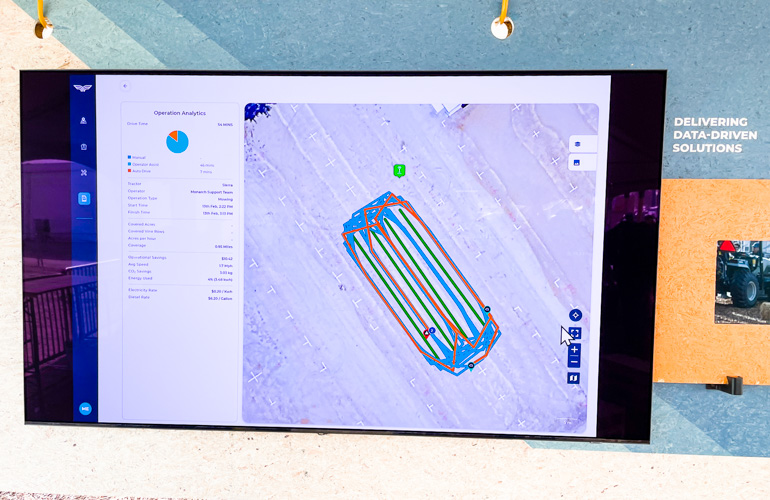
The new Wingspan.ai software from Monarch Tractor is both a fleet manager and a tractor data management application. | Credit: The Robot Report
I have been covering Monarch Tractor since the company emerged from stealth in 2020. At the World Ag Expo last year, the company was featured only at partner booths. However, this year, Monarch Tractor had a booth and demo area that was bigger than John Deere or any of the other “veteran” tractor companies at the show. The company has raised over $80M in the last two years and began shipping its first production units in November of 2022. The company also signed a deal with Foxconn to start manufacturing the tractor in its Lordstown OH manufacturing facility.
So it should be no surprise that the company made such a huge investment in marketing for this event. The company is now making revenue and has a deep backlog of customers ready to buy and deploy the tractors. Every marketing dollar spent can be justified with a potential sale.
At the show, Monarch introduced a new fleet management software package called Wingspan.ai. Wingspan includes a new user interface and a feature set that simplifies the deployment, management, and maintenance of the tractors deployed on a farm. The company fully expects some customers to deploy more than one tractor, so fleet management features are key to controlling the day-to-day operations of the tractors.
Monarch is an open-source data platform and the company plans to make all of the information available about the Monarch tractor operations.
CEO Praveen Penmentsa has a vision where all of this tractor operational information flows upward and is consolidated for the farmer.
Carbon Robotics
Carbon Robotics created an autonomous weeder that uses lasers to zap the weeds and instantly kill them without any dangerous chemicals. In many ways, it’s the ideal solution for managing weeds without disturbing the soil or introducing harmful chemicals that might impact humans, animals, and pollinators.
There were no big announcements from Carbon Robotics this year other than the addition of new crops to the solution. This means that they have new vision identification models for new crops that expand the application for additional crops.
Most notably this year at the show, there was no autonomous version of the Carbon Robotics solution on display. The company is now all in on the smart implement version of its laser-wielding weeder. Both Carbon Robotics and Farmwise have arrived at the same conclusion: single-row autonomous platform cultivation solutions are not as economically viable as a multi-row, smart-implement version of the solution. It’s simple math, when you can cover three times the area in one pass, you can do the work three times faster. This is just the start of the smart-implement market.
The company also introduced an on-tractor power generator for the smart implement that provides onboard power for the unit using the PTO on the tractor.
Farm-NG
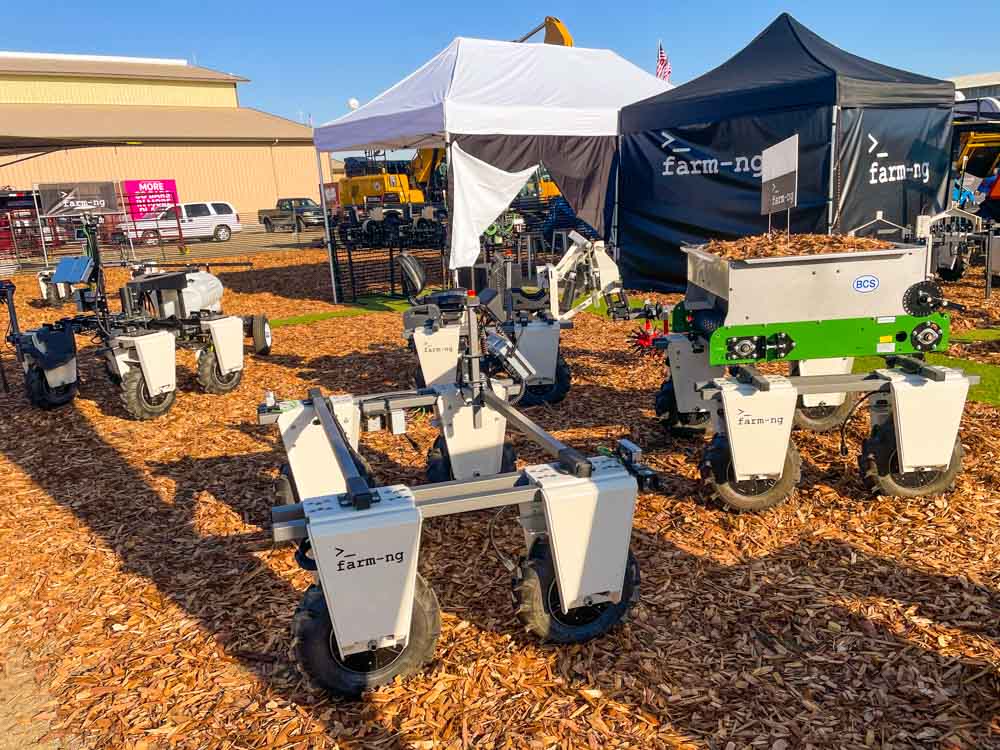
Farm-NG provides a variety of configurable components that can be put together to create any number of different style autonomous vehicles for the farm. | Credit: The Robot Report
Farm-NG is an Ag-robotics startup that launched its solutions at this show. The product is an industrial erector set-like platform with open-source software for the development of custom, autonomous farm machines. The Farm-NG product line includes a number of motors, linear actuators, sensors, cameras and a central control unit, all of which are plug-and-play over the CAN bus. It also includes ag-specific attachments such as discs, furrows, blades, tines, a seeding assembly, an integrated compost spreader, and a bunch of other miscellaneous components.
The genius of the system is its modularity and openness. Farmers are tinkerers, and this is the perfect toolkit for any small to medium-sized farming operation. The software included with the onboard controller is designed to be completely programmable through the touchscreen interface. This enables control over the various motors and attachments. However, the system is also completely open, and a programmer can extend the capabilities and write complex, vision or sensor-guided control algorithms. The system also enables secure, remote monitoring and remote teleoperation of the rig through either a WiFi or cellular network.
Bluewhite Robotics
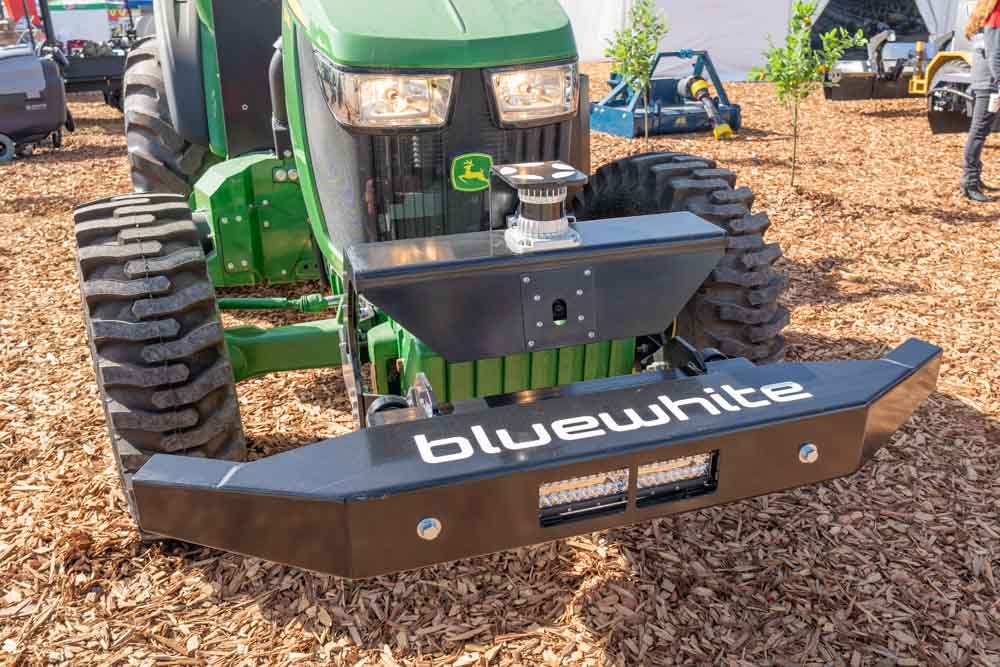
This John Deere tractor has been converted into an autonomous tractor with Bluewhite autonomy package. | Credit: The Robot Report
Bluewhite is an Israeli startup that can automate any existing tractor with the addition of a sensor package and control actuators. The business model for BlueWhite is to work with the existing fleet of tractors that are owned by a farmer and add on the controls that convert the fleet into fully autonomous vehicles, while still preserving the manual drive capabilities of the vehicle.
The company has already converted a number of tractor models from the leading tractor manufacturers. They design custom actuators for steering, throttle, brakes, transmission, etc, that can be retrofitted onto the vehicles. As the company engineers these actuators for a new model, it is building a portfolio of controls that it can leverage for subsequent customers.
The company has a software package that enables remote monitoring and teleoperation of the solution. The software does rely on GPS, RTK or Comms for successful operation. Smart implements are also controllable providing autonomous operations from seed to harvest.
Bluewhite operates a robot as a service (RaaS) model that enables farmers to operate the equipment locally while Bluewhite monitors the operation continually and handles exceptions and errors to preserve uptime and continuity.
Amos Power
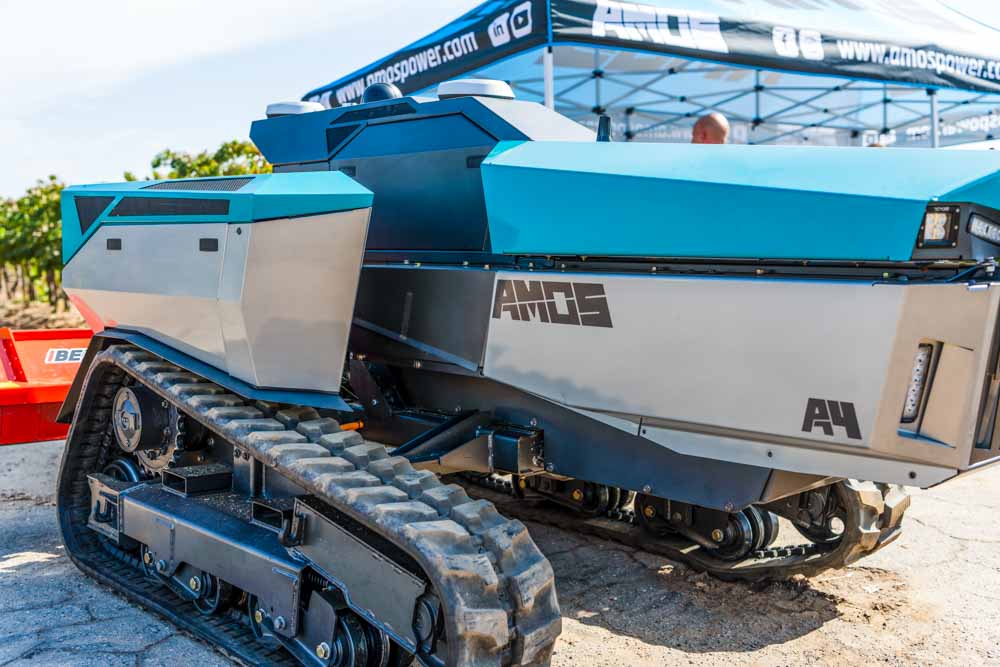
Amos Power launched its new all-electric autonomous tractor. | Credit: The Robot Report
Amos Power is another startup that launched its autonomous tractor at the 2023 WAE. The company is building a completely autonomous, all-electric, tracked tractor. The platform features three separate electric motors, one for each drive train and a separate electrically driven PTO. This enables the PTO to run at a speed and power setting that is different from the drive train of the tractor.
The Amos Power tractor is fully autonomous and does not include a driver’s seat or any way for a farmer to ride in the vehicle. This is different from many of the other competitors and puts Amos Power into the unmanned autonomy segment of the market.
The tractor weighs 2500 kg (6600 lbs) and has a drawbar horsepower of 75-85 hp. The PTO has 34-40 hp. The company is currently taking reservations for its production generation of vehicles.
Guardian Agriculture
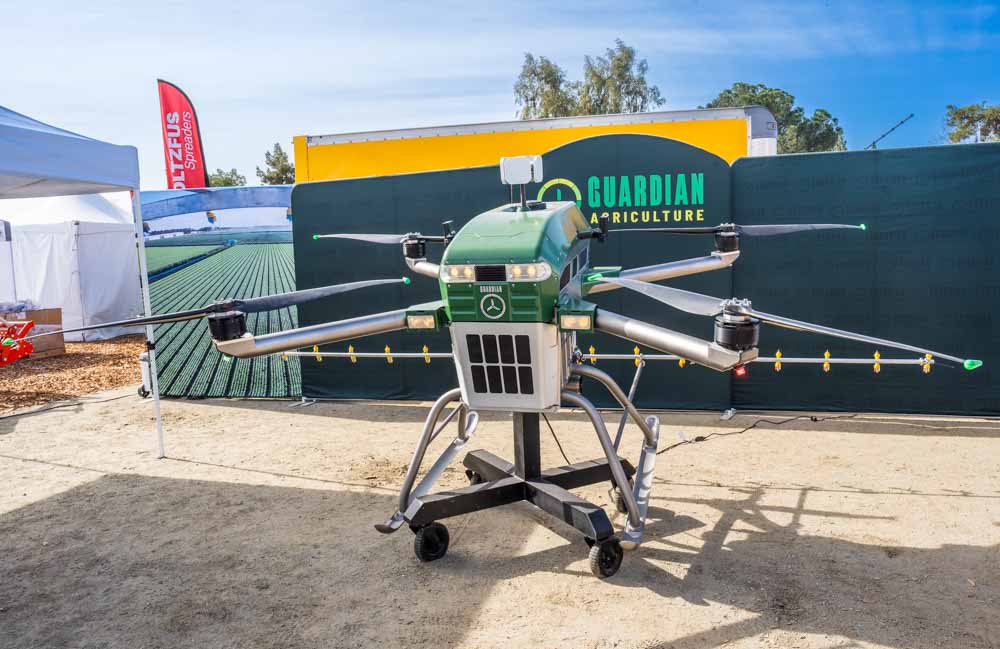
Guardian Ag launched its autonomous, unmanned crop-spraying drone. | Credit: The Robot Report
Guardian Agriculture was one of the few aerial unmanned solutions on display at the show. The Guardian SC-1 is a four-prop drone that features 1.5 m (60-inch) propellers and a 76 Liter (20 gal) payload. The vehicle is designed for autonomous aerial spraying operations and is designed to be operated by a single operator who is managing flight operations and the refilling station. The SC-1 would typically fly for 3-4 minutes before emptying its onboard tank and returning to the refill/recharge station. A quick five-minute refill/recharge puts the drone back into the air for continuous operations until all tasks are completed.
The company is currently developing a larger version of the platform that will feature 2 m (80-inch) props and a large capacity tank to extend flight capabilities.
Operators are required to acquire all of the appropriate drone flight and chemical handling certifications before operating the drone.
Beewise
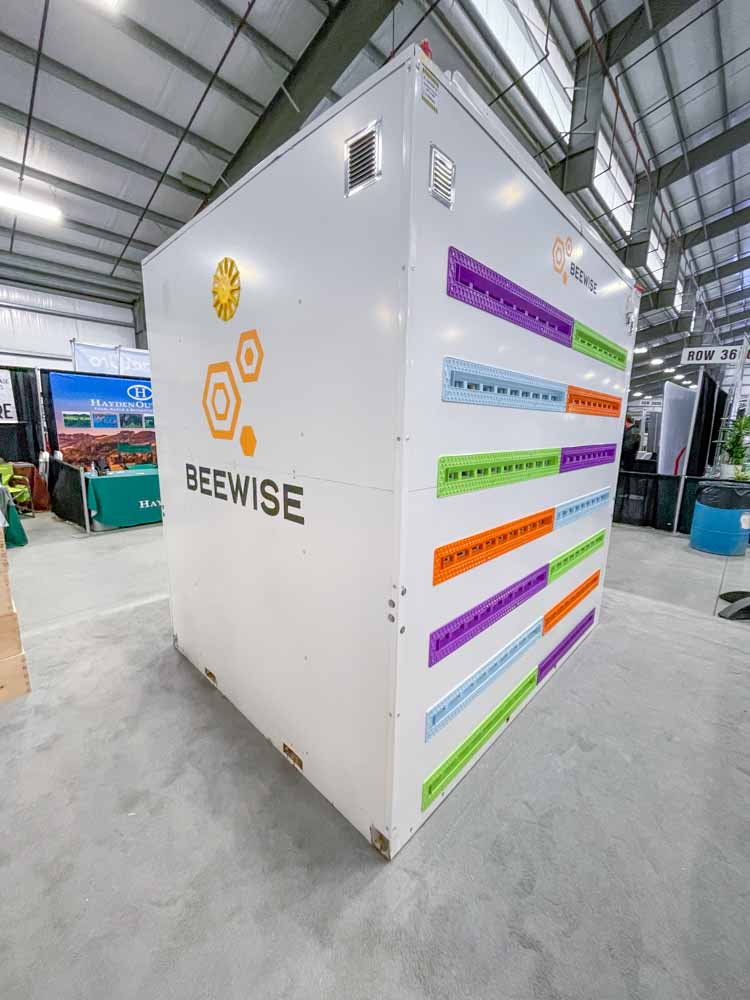
Beewise is innovating the beekeeping industry with a fully autonomous beehive that provides real-time data on bee health and activity. | Credit: The Robot Report
One of the most unique autonomous innovations on display at the show was the Beewise beehome. This is a climate-controlled, solar-powered, remotely monitored beehive with a capacity of up to 24 different hives. The base unit measures 2.5m x 2m x 2m (8 feet x 6.5 feet x 6.5 feet), and weighs less than a ton without the colonies inside.
In addition to monitoring the bee hives and alerting the hive owner to the health of the bees, the unit also features an internal robot that autonomously harvests honey. The robot extracts the individual honeycombs from a hive, gently swiping the bees from the frame during the extraction process. The robot then inserts the frame into an extraction unit that spins the frame at high speed to extract the honey. The frames are then returned to the hive.
The hive operators also received real-time alerts tracking bee movements and other alert conditions.
Vinergy Inc
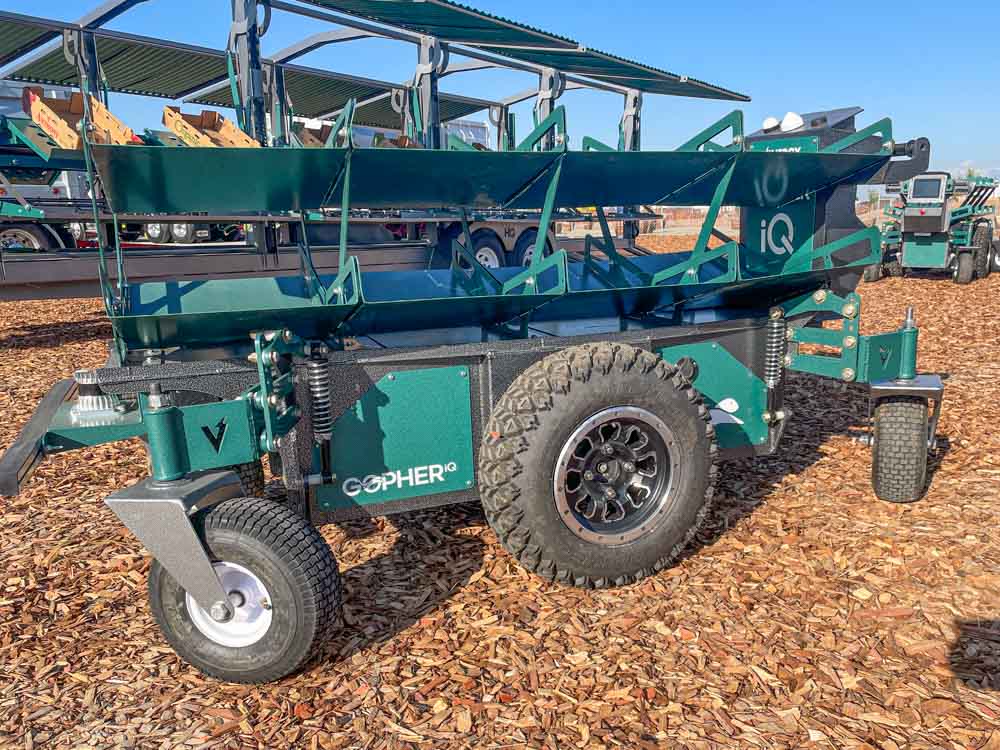
Vinergy developed an AMR for moving grape boxes from the crop row to the in-field pack-out station so that grape harvesters do not need to leave the row. | Credit: The Robot Report
Vinergy Inc is an experienced machine builder that is expanding it product portfolio to include automation for grape farmers. The company introduced the Gopher IQ autonomous tray mover to support the table grape harvesting process by moving filled boxes of grapes from the in-field rows to a central in-field packing station. This use case keeps the harvesting crew from having to leave their in-row location to deliver the filled boxes to the packing stations, typically a time-wasted operation for the harvesters. Due to the fragility of the crop, table grapes need to be harvested by hand.
The system is provided with a robots-as-a-service (RaaS) business model. The Gopher HQ solution is a manual pack-out station for grape harvesting that provides a mobile packing station structure that can be easily moved anywhere in the field. It includes eight pack out stations, combined with an automated outfeed belt that queues cases of product. The HQ folds down and is designed to trailer up to three Gopher iQ units for transport on the road. The solution is available for deployment during the 2023 harvest season.
The company is also producing the Rhino, a new solution designed for the dairy feeding application. The Rhino is designed to operate in a dairy barn and push the cow feedback within reach of the herd as they feed.
The company also recently secured a grant to work with aerial drone vendor Tevel to provide a ground-based platform to move the battery pack for the harvesting drones, while also providing the structure for gathering fruit. The prototype unit is a much smaller scale than the S&S base unit shown elsewhere at the show, and it was optimized for safely packing stone fruit (peaches, apricots) that are more fragile than apples.
Burro
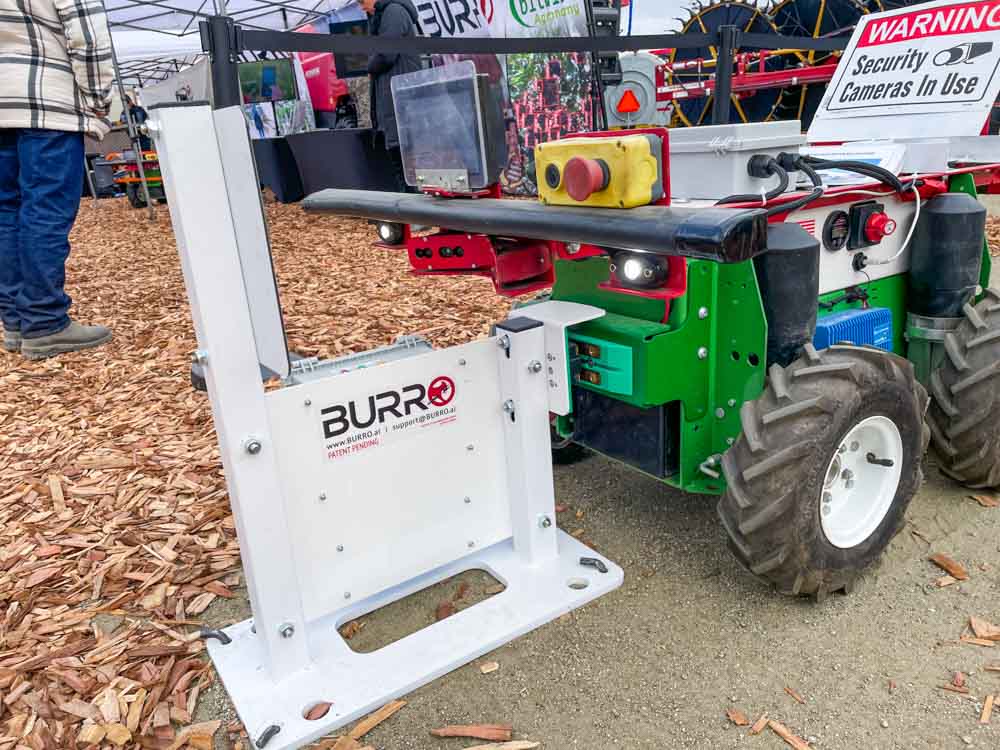
Burro launched a new autonomous charging station for the Burro AMR. | Credit: The Robot Report
Burro had a number of autonomous units on display at the show. The company is expanding operations with new scouting payload features. CEO Charlie Andersen describes the new security patrol feature as an opportunity for current (and future) Burro operators to extend the usage of their Burro mobile robots after the working day. Unfortunately, farmers are often the target of thieves during the overnight hours, when valuable crops and/or equipment are stolen. By deploying Burros equipped with additional cameras and sensors to patrol remote areas of the farm, farmers can feel more secure that they will be alerted to issues.
The company has also released a new charging station that enables Burros to autonomously recharge the battery without the need for manual plug-in or battery swap. This also supports the security patrol workflow by enabling the vehicles to charge themselves during overnight hours.
Pollination is another task that Burro is pursuing. Burro has started a partnership with Bloomx.ai to deploy a blueberry pollinating payload to the burro and have the vehicle autonomously traverse a field. Pollination for blueberries occurs by shaking the branches and moving the pollen from the male to the female flowers.
Finally, the company is pursuing the solar market including mowing weeds throughout a solar installation, as well as autonomously shuttling solar panels for workers during an install.
Naio Technologies
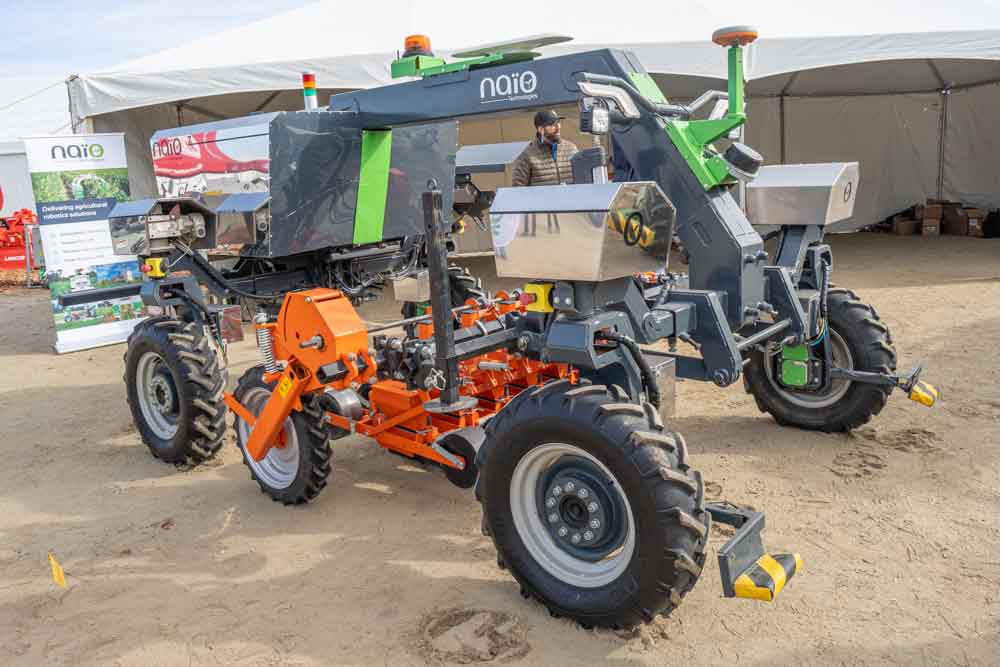
Naio Technologies demonstrated its complete lineup of autonomous tractors designed for specific crops. | Credit: The Robot Report
Naio Technologies had demo units on display for each of the various autonomous tractors in its portfolio. From the tiny Oz robot to the much larger Orio and Ted platforms. Naio has an established base of users in its native France, and the company is now expanding operations to the USA. The company focuses primarily on weeding and spraying operations in vegetable crops and especially in grapes and vineyards. All of the vehicles in the Naio lineup are unmanned autonomous vehicles and the Orio and Ted platforms carry the implement between the wheel base, which simplifies the safety requirements and the overall driving and control of the vehicle.
Credit: Source link


Comments are closed.